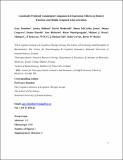Genetically predicted complement component 4A expression: effects on memory function and middle temporal lobe activation
Date
2018-01-09Author
Donohoe, Gary
Holland, Jessica
Mothersill, David
McCarthy Jones, Simon
Cosgrove, Donna
Harold, Denise
Richards, Alex
Mantripragada, Kiran
Owen, Michael J.
O’Donovan, Michael C.
Gill, Michael
Corvin, Aiden
Morris, Derek W.
Metadata
Show full item recordUsage
This item's downloads: 229 (view details)
Cited 12 times in Scopus (view citations)
Recommended Citation
Donohoe, G., Holland, J., Mothersill, D., McCarthy-Jones, S., Cosgrove, D., Harold, D., Richards, A., Mantripragada, K., Owen, M. J., O'Donovan, M. C., Gill, M., Corvin, A., Morris, D. W. (2018). Genetically predicted complement component 4A expression: effects on memory function and middle temporal lobe activation. Psychological Medicine, 48(10), 1608-1615. doi: 10.1017/S0033291717002987
Published Version
Abstract
Background
The longstanding association between the major histocompatibility complex (MHC) locus and schizophrenia (SZ) risk has recently been accounted for, partially, by structural variation at the complement component 4 (C4) gene. This structural variation generates varying levels of C4 RNA expression, and genetic information from the MHC region can now be used to predict C4 RNA expression in the brain. Increased predicted C4A RNA expression is associated with the risk of SZ, and C4 is reported to influence synaptic pruning in animal models.
Methods
Based on our previous studies associating MHC SZ risk variants with poorer memory performance, we tested whether increased predicted C4A RNA expression was associated with reduced memory function in a large (n = 1238) dataset of psychosis cases and healthy participants, and with altered task-dependent cortical activation in a subset of these samples.
Results
We observed that increased predicted C4A RNA expression predicted poorer performance on measures of memory recall (p = 0.016, corrected). Furthermore, in healthy participants, we found that increased predicted C4A RNA expression was associated with a pattern of reduced cortical activity in middle temporal cortex during a measure of visual processing (p < 0.05, corrected).
Conclusions
These data suggest that the effects of C4 on cognition were observable at both a cortical and behavioural level, and may represent one mechanism by which illness risk is mediated. As such, deficits in learning and memory may represent a therapeutic target for new molecular developments aimed at altering C4’s developmental role.


